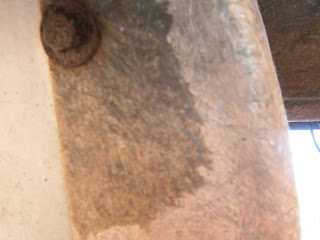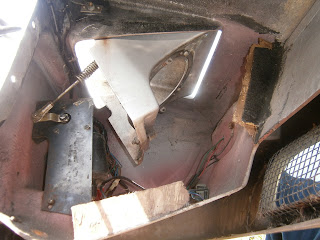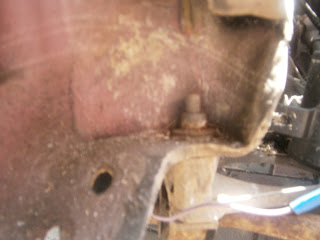You can get replacements- here from Lotusbits. These don't actually look like mine and I thought mine were both the same shape... but it seems these are tailored for each side.
** I found an article in New Scientist (June 1984) about composite car construction. They state that the panels are to "decelerate crash loads" and limit the damage in collision tests to in front of the wheel arches.
In any event its an unsatisfactory design because the wood always rots and once rotten its not going to decelerate anything. My guess-0 unless you have had them fixed then every Excel on the road has no such deceleration protection! Further, as they are fibre glassed in, the old bits are tricky and messy both to remove and replace. I had already removed the radiator and bottom tray from the radiator duct box in preparation for the motor swap. As I had already noted that my panels were shot, this seemed like a good time to replace them.
I should point out that I can get confused with my descriptions here. I am working from in front of the car but even so I'm trying to give all descriptions from the driver's point of view. I. E. forward means towards the nose and rearwards towards the motor. However from my working perspective these are reversed so if I slip up occassionally apologies!
The first step was to get some access and this means removing the rest of the radiator duct box. This is held by a total of 7 bolts- 3 on the rear vertical edges of the box (ie in the engine compartment and already removed) and 4 underneath the car securing the bottom of the duct. In addition there are two other bolts nearest the motor (and already removed) which secured the back end of the bottom tray of the duct box.
 |
| View of the box in situ from the engine compartment. The vertical edge bolts already removed. |
Looking under the car I could locate the 4 securing bolts (13 mm). I sprayed these with penetrating lube although I don't think it helped!
 |
| Frontmost LHS mounting bolt behind nose |
 |
| Forward RHS mounting bolt - the rearmost one (and the tray mounting bolt) having already been removed with difficulty as explained in a previous blog. |
 |
| The radiator box also has these two bolts which retain the horns. I was hoping not to need to remove these, and two large blanking grommets- no idea why they were there. |
 |
| Radiator box unclipped |
 |
| Horns in position on the rad box. |
 |
| Radiator box withdrawn- horns detached. |
 |
| Section showing the glass matting that secured the wooden panel. |
 |
| Disgusting shower of rotten wood- not at all what you expect from a high end motor. |
The left hand panel has mountings for the compressor- I measured these so I can refit the thing in something approaching the same position when I refashion the panels. The bolts are positioned 3 and 6.5 inches from the edge of the panel and 5 inches down from the top edge.
 |
| Forward bolt 6.5 " in form edge- this is the bolt I could see from the other side when the panel was in place. |
This panel has a 6.5 inch cut-out. I have a template but it isn't this shape in this area so this sort of info might be useful. The compressor is mounted in these threaded Tee bolts which are hammered into the wood from behind.
 |
| Tee mounting removed from wood- threaded Rivnut like structure has teeth to grip the wood. |
 |
| Back of tee mounting hammered flush with wood. |
Cutting the panels
I bought some 12 mm exterior ply, a small panel is enough for three nose panels. The specified grade is marine ply; but the exterior grade is just as waterproof and has to be stronger than the rotten stuff that was there before!
I used a template I had been sent by another forum member- if you want to see what I used, I have "digitized" it as a spread sheet here. To reconstitute this you will need a large piece of paper- at least 60 x 70 cms. Draw a diagonal across it from top right to bottom left. You can then mark a point about 10 cms or so from one corner and then make another mark 56.3 cms further on from this. This then represents the longest dimension of the panel. Divide the region between by making marks every two cm. Draw grid lines at right angles to the diagonal above and below the line at each of the 2 cm marks and then make a mark on them at the positions indicated in the spreadsheet both above and below the diagonal line. Some "special" points are indicated which will locate corners or low points. Finally, join the dots to generate the profile. Your profile should like like that below except it will be upside down as I have reorientated this template in the same sense as the car.
 |
| Plywood as cut out. The point fits into the front of the nose so the front of the car (forward) is to the right |

The ply fits nicely onto the sides of the fibre glass radiator box- which is promising- but there were three problems... I suspect that this could be because the template was generated for a later car and mine is one of the early ones.
Firstly, its clear from the pic above that the lower part at the front doesn't follow the curve of the radiator box (or of the car nose itself) - there is an unsightly gap (bottom right). This could be corrected by simply projecting the line of the front section downwards and that of the base forwards.
Secondly, the panel I removed didn't have this fancy curved section at the top left (pic reproduced below)

The picture below shows the original profile and the modified profile I ended up with (including the detachable section). I will copy this onto paper and produce a more tailored "digitised" template to go with the first. I treated both panels to a good soaking in Cuprinol wood preservative paying special attention to the cut edges. I followed this with two coats of yacht varnish.
 |
| Original profile |
I also "digitized" this panel profile and added it to the spreadsheet above. This is a larger profile and I would recommend cutting this one first as a trial fit- after all you can always make it smaller if you need to!
 |
| Larger profile as "digitised" If you are drawing my modified template then it should look like this when re-drawn. |
Fitting the panels:
This is the space into which the above panel should fit. The old panel was retained by fibreglass sheets in three positions:
 |
| Fibreglass matting fixings on lower and forward edges of the headlamp void, note inner leaf of the front mounting painted black |
At the front of the car (right in this pic) the sloping section was held between two folded fibreglass mats. As the wood has effectively disintegrated, these are now left standing with a handy wood-sized space between them. The sheet nearest the radiator is visible in this view painted black. Sadly its not possible to just slip the new panel into this groove because there is insufficient clearance.
At the base the wood was held against a single folded section of fibre glass matting visible in the photograph as an upstand.
At the rear the panel fits into a recess in the bulkhead. Additional matting sections held it in this groove
These matting mountings seem to be designed to hold the wood in place and prevent lateral movement, but they are not strong and would have little resistance in the case of sideways impacts. The strength of this arrangement is really only in the fore-and-aft direction. Head-on collision loads would compress the panel backwards into the moulded groove, transferring nose loads to the next bulkhead. The existing fibreglass can however be used to position the wood. In order to do this I had to cut off the black painted side of the fibreglass pair above.
 |
| Inner leaf of forward section removed exposing the outer sheet. |
I removed the innermost section matting from the forward pair (i.e. the black painted leaf). This exposed the back of the mounting and meant that I could test fit the panel by pushing it into place, back against the 2 remaining fibreglass leaves.
 |
| Test fitting of panel |
 |
| Right hand panel fitted in the same way, infill fillet could be positioned at lower right. I still need to drill this panel for the compressor mountings |
I decided to dispense with my infill panels as I was now convinced that this space was always open. I amended the panels to the same profile in the lower corner and re-fitted the compressor mountings to the RHS before proceeding. Left hand panel stuck in place using waterproof adhesive ("No more nails extererior grade"). This was spread on the remaining fibreglass upstands and also along the edges of the nose and into the bulkhead recess. The panel was then pressed back into position and the adhesive smoothed over to fill any gaps. Remember to slip the compressor behind the Right hand panel before fitting and route out the wires through the top rear cut-out. Note the compressor mounting points restored before the panel was fitted.
 |
| Right hand panel first fit |
 |
| Left hand panel first fit. |
 |
| Matting fibre-glassed in |
 |
| Matting fibre glassed in. |
As predicted fibre glassing through the headlamp opening was challenging! I think if doing the job again I would definitely remove the pods- but in my case sorting the pods out was one of the jobs I did right back at the start of this project and I couldn't face undoing all that again! Anyway I did manage to get fibreglass matting on the backs of the panels, covering the up-stands remaining form the old wood and extending past them to stick onto the new.
I filled in around the rear of the wood (where it slips into the bulkhead) using builders foam.
 |
| Foam installed behind compressor |
The new wood is now in and I'm pleased I have a reconstituted nose section now. I think we are all impressed by the Elite winning the Don safety trophy.... but with duff panels I don't think it would have passed!

















No comments:
Post a Comment
Feel free to let me know what you think of this blog. I'm working on my own here so any feedback from those Lotus enthusiasts floating around "Blogger Bank" is welcome. Suggestions for process improvements especially welcome. If you like it please follow.